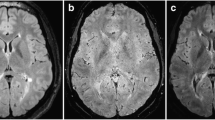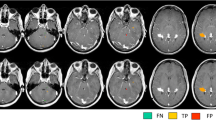Abstract
Objectives
To investigate whether a new magnetic resonance image (MRI) technique called T2*-weighted fluid attenuation inversion recovery (FLAIR*) can differentiate between multiple sclerosis (MS) and vascular brain lesions, at 7 Tesla (T).
Methods
We examined 16 MS patients and 16 age-matched patients with (risk factors for) vascular disease. 3D-FLAIR and T2*-weighted images were combined into FLAIR* images. Lesion type and intensity, perivascular orientation and presence of a hypointense rim were analysed.
Results
In total, 433 cerebral lesions were detected in MS patients versus 86 lesions in vascular patients. Lesions in MS patients were significantly more often orientated in a perivascular manner: 74 % vs. 47 % (P < 0.001). Ten MS lesions (2.3 %) were surrounded by a hypointense rim on FLAIR*, and 24 MS lesions (5.5 %) were hypointense on T2*. No lesions in vascular patients showed any rim or hypointensity. Specificity of differentiating MS from vascular lesions on 7-T FLAIR* increased when the presence of a central vessel was taken into account (from 63 % to 88 %), most obviously for deep white matter lesions (from 69 % to 94 %). High sensitivity remained (81 %).
Conclusion
7-T FLAIR* improves differentiation between MS and vascular lesions based on lesion location, perivascular orientation and presence of hypointense (rims around) lesions.
Key Points
• A new MRI technique T2*-weighted fluid attenuation inversion recovery (FLAIR*) was investigated.
• FLAIR* at 7-T MRI combines FLAIR and T2* images into a single image.
• FLAIR* at 7 T does not require enhancement with contrast agents.
•High-resolution 7-T FLAIR* improves differentiation between MS and vascular brain lesions.
• FLAIR* revealed a central vessel more frequently in MS than vascular lesions.





Similar content being viewed by others
References
Montalban X, Tintoré M, Swanton J et al (2010) MRI criteria for MS in patients with clinically isolated syndromes. Neurology 74:427–434
Polman CH, Reingold SC, Banwell B et al (2011) Diagnostic criteria for multiple sclerosis: 2010 revisions to the “McDonald criteria. Ann Neurol 69:292–302
Fazekas F, Barkhof F, Filippi M et al (1999) The contribution of magnetic resonance imaging to the diagnosis of multiple sclerosis. Neurology 53:448–456
Charil A, Yousry TA, Rovaris M et al (2006) MRI and the diagnosis of multiple sclerosis: expanding the concept of “no better explanation. Lancet Neurol 5:841–852
Schmidt R, Schmidt H, Haybaeck J et al (2011) Heterogeneity in age-related white matter changes. Acta neuropathol 122:171–185
Pantoni L (2010) Cerebral small vessel disease: from pathogenesis and clinical characteristics to therapeutic challenges. Lancet Neurol 9:689–701
Kollia K, Maderwald S, Putzki N et al (2009) First clinical study on ultra-high-field MR imaging in patients with multiple sclerosis: comparison of 1.5 T and 7 T. AJNR Am J Neuroradiol 30:699–702
Mainero C, Benner T, Radding A et al (2009) In vivo imaging of cortical pathology in multiple sclerosis using ultra-high field MRI. Neurology 73:941–948
Pitt D, Boster A, Pei W et al (2010) Imaging cortical lesions in multiple sclerosis with ultra-high-field magnetic resonance imaging. Arch Neurol 67:812–818
De Graaf WL, Kilsdonk ID, Lopez-Soriano A et al (2013) Clinical application of multi-contrast 7-T MR imaging in multiple sclerosis: increased lesion detection compared to 3 T confined to grey matter. Eur Radiol 23:528–540
Wattjes MP, Barkhof F (2009) High field MRI in the diagnosis of multiple sclerosis: high field-high yield? Neuroradiology 51:279–292
Dawson J (1916) The histology of disseminated sclerosis. Trans R Soc Edinburgh 50:517–740
Fog T (1965) The topography of plaques in multiple sclerosis with special reference to cerebral plaques. Act Neurol Scan Suppl 15:1–161
Ge Y, Zohrabian VM, Grossman RI (2008) Seven-Tesla magnetic resonance imaging: new vision of microvascular abnormalities in multiple sclerosis. Arch Neurol 65:812–816
Tallantyre EC, Brookes MJ, Dixon JE et al (2008) Demonstrating the perivascular distribution of MS lesions in vivo with 7-Tesla MRI. Neurology 70:2076–2078
Hammond KE, Metcalf M, Carvajal L et al (2008) Quantitative in vivo magnetic resonance imaging of multiple sclerosis at 7 Tesla with sensitivity to iron. Ann Neurol 64:707–713
Ropele S, de Graaf W, Khalil M et al (2011) MRI assessment of iron deposition in multiple sclerosis. J Magn Reson Imaging 34:13–21
Sati P, George IC, Shea CD et al (2012) FLAIR*: a combined MR contrast technique for visualizing white matter lesions and parenchymal veins. Radiology 265:926–932
Conijn MMA, Geerlings MI, Luijten PR et al (2010) Visualization of cerebral microbleeds with dual-echo T2*-weighted magnetic resonance imaging at 7.0 T. J Magn Resance imaging: JMRI 32:52–59
Polman CH, Reingold SC, Edan G et al (2005) Diagnostic criteria for multiple sclerosis: 2005 revisions to the “McDonald Criteria. Ann Neurol 58:840–846
Visser F, Zwanenburg JJM, Hoogduin JM, Luijten PR (2010) High-resolution magnetization-prepared 3D-FLAIR imaging at 7.0 Tesla. Magn Reson Med 64:194–202
Bian W, Harter K, Hammond-Rosenbluth KE et al (2013) A serial in vivo 7 T magnetic resonance phase imaging study of white matter lesions in multiple sclerosis. Mult Scler 19:69–75
Grabner G, Dal-Bianco A, Schernthaner M et al (2011) Analysis of multiple sclerosis lesions using a fusion of 3.0 T FLAIR and 7.0 T SWI phase: FLAIR SWI. J Magn Reson Imaging 33:543–549
Böhning D, Holling H, Patilea V (2011) A limitation of the diagnostic-odds ratio in determining an optimal cut-off value for a continuous diagnostic test. Stat Methods Med Res 20:541–550
Barkhof F, Filippi M, Miller DH et al (1997) Comparison of MRI criteria at first presentation to predict conversion to clinically definite multiple sclerosis. Brain 120:2059–2069
Bø L, Vedeler CA, Nyland H et al (2003) Intracortical multiple sclerosis lesions are not associated with increased lymphocyte infiltration. Mult Scler 9:323–331
Kilsdonk ID, de Graaf WL, Barkhof F, Wattjes MP (2012) Inflammation high-field magnetic resonance imaging. Neuroimaging Clin N Am 22:135–157
Tan IL, van Schijndel RA, Pouwels PJW et al (2000) MR venography of multiple sclerosis. AJNR Am J Neuroradiol 21:1039–1042
Tallantyre EC, Dixon JE, Donaldson I et al (2011) Ultra-high-field imaging distinguishes MS lesions from asymptomatic white matter lesions. Neurology 76:534–539
Wuerfel J, Sinnecker T, Ringelstein EB et al (2012) Lesion morphology at 7 Tesla MRI differentiates Susac syndrome from multiple sclerosis. Mult Scler 18:1592–1599
Sinnecker T, Dörr J, Pfueller CF et al (2012) Distinct lesion morphology at 7-T MRI differentiates neuromyelitis optica from multiple sclerosis. Neurology 79:708–714
Lummel N, Boeckh-Behrens T, Schoepf V et al (2011) Presence of a central vein within white matter lesions on susceptibility weighted imaging: a specific finding for multiple sclerosis? Neuroradiology 53:311–317
Kau T, Taschwer M, Deutschmann H et al (2013) The “central vein sign”: is there a place for susceptibility weighted imaging in possible multiple sclerosis? Eur Radiol 23:1956–1962
Tallantyre EC, Morgan PS, Dixon JE et al (2009) A comparison of 3 T and 7 T in the detection of small parenchymal veins within MS lesions. Invest Radiol 44:491–494
Tan IL, Pouwels PJW, van Schijndel RA et al (2002) Isotropic 3D fast FLAIR imaging of the brain in multiple sclerosis patients: initial experience. Eur Radiol 12:559–567
Acknowledgements
This work was supported by the Dutch MS Research Foundation (grant nr 11–769).
Author information
Authors and Affiliations
Corresponding author
Rights and permissions
About this article
Cite this article
Kilsdonk, I.D., Wattjes, M.P., Lopez-Soriano, A. et al. Improved differentiation between MS and vascular brain lesions using FLAIR* at 7 Tesla. Eur Radiol 24, 841–849 (2014). https://doi.org/10.1007/s00330-013-3080-y
Received:
Revised:
Accepted:
Published:
Issue Date:
DOI: https://doi.org/10.1007/s00330-013-3080-y




